DIP POLE GYBES USING LAZY SHEETS AND GUY
 Kame Richards / Pineapple Sails
Kame Richards / Pineapple Sails
This is a detailed description of the steps needed to complete a dip pole gybe on a boat in the 35
foot plus range.
This style of gybe would work well in six knots of apparent wind or more. If the spinnaker collapses
during the "square back" step because the apparent wind speed drops too low for the sail to fly, a
different style of gybe
is needed. (See a future article on this subject.)
The information is available in two outline forms, this one, which is a chronological overview of
the whole boat...essentially a managers view,
and a second one, reorganized to the job-specific
view showing what each task should be doing, in order. The jobs are divided up into tasks, not necessarily requiring
a person dedicated to
each task, but something which must be done.
If you haven't done so already, take a moment and establish some 'pre-determined marks' to help gybe
the spinnaker pole. With no spinnaker up, rig the spinnaker pole to the car on the mast and the topping
lift. We want to determine two things: (1) the height of the car on the mast and (2) the location on
the toppinglift which will allow the spinnaker pole to dip behind the forestay and stay above the bow
pulpit, so the foredeck person can easily reach the pole tip. A piece of white tape on both sides of
the mast make good markers for the spinnaker pole car, and , for the topping lift, a large black band
completely around the topping lift about 4 inches long and an alignment mark on the deck (in front of
the winch).
An explanation of the graphics
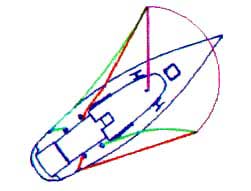 "SET-UP" This
call comes from the driver. "SET-UP" This
call comes from the driver.
- DRIVER
- Call "set up for the gybe" loud enough for everyone to hear. Get an idea on what the heading is
going to be on the new gybe. Watch how quickly the
crew is getting ready. Are they covering all bases?
- BOW PERSON
- Be sure you have enough lazy afterguy at your disposal. Double check that the lazy spinnaker sheet
is OVER the top of the spinnaker pole, not hanging
down outside the pole tip.
- MAST PERSON
- TOPPING LIFT
- Place topping lift around winch, and if there is a sheet stopper, be sure
it is all the way open.
- AFTERGUY
- Prepare the afterguy to be squared back (needs a handle).
- LAZY SHEET
- Get the lazy sheet around a winch. It will need a handle soon too. Constantly watch to be sure the
lazy sheet stays on top of the spinnaker pole.
- FOREGUY
- Get somebody on the foreguy (it will need easing).
- LAZY GUY
- Remove all wraps from the winch so the bow person can pull out the necessary
slack.
- SHEET
- Get ready to ease during the "square-back."
- MAINSAIL
- Cleat the traveler on both sides to prevent the traveler car from banging into the end of the track.
Get ready to ease the main sheet during the
gybe.
-
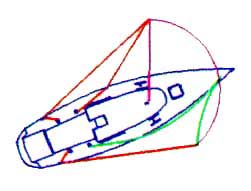 "SQUARE
BACK" This call comes from the driver. "SQUARE
BACK" This call comes from the driver.
- DRIVER
- Start the boat bearing off, usually before you ask for the square back, but after you are convinced
the important bases are covered. Watch the spinnaker and the mast head windex, and the angle of heel.
Keep the cockpit
crew appraised of how the bear-off is going, like slowly, or move faster!
- BOW PERSON
- Hold the lazy guy your favorite way to get it into the pole jaw properly. Watch the driver and angle
of heel for clues as to when the "trip" call
will come.
- MAST
- Hold onto the trip line on the pole.
- TOPPING LIFT
- Start easing the topping lift slightly (inches), and know where the pre-determined
mark on the topping lift is for life-line and pulpit clearance for
the spinnaker pole.
- AFTERGUY
- Grind aft the afterguy, being careful not to collapse the spinnaker.
- LAZY SHEET
- Trim aft the lazy sheet along with the afterguy. From now on the lazy sheet
needs to be kept tight.
- FOREGUY
- Ease the foreguy as the pole moves aft.
- LAZY GUY
- SHEET
- Ease the sheet as the boat bears off, being careful not to collapse the
spinnaker.
- MAINSAIL
- Ease the mainsheet as the boat bears off.
-
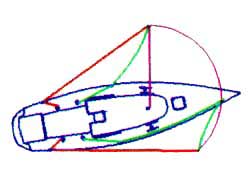 "TRIP" This
call comes from the driver. "TRIP" This
call comes from the driver.
- DRIVER
- The first time the boat heels to weather, call "TRIP!" loud enough for all the crew to hear. Keep
the boat turning continuously through the gybe. DO NOT try to sail dead down wind while the gybe is
completed. In light
air the boat will not heel to weather, so call "TRIP" just before the boat
is on a dead-down-wind heading.
- BOW PERSON
- Focus on the incoming pole. Hold the lazy guy in two hands with about a foot of guy between them.
Catch the jaws of the pole with this loop. Resist
the urge to catch the pole with your hands.
- MAST
- Trip open the pole jaw with the trip line, and swing the pole in towards the bow with the trip line.
Look to be sure the pole jaw has really opened and the old afterguy has come out. Your next area of
concern will be helping
to get the topping lift back up by bouncing at the mast. Move in that direction.
- TOPPING LIFT
- Look at the black mark on the topping lift and ease quickly to the proper location. Focus on the
mark more than the pole. If the car on the mast is in the right place the pole will end up in the right
place.
- AFTERGUY
- As soon as the "trip" call is made, ease the afterguy about a foot. Leave it uncleated. It has no
more bearing on this gybe. Find another job, like
grinding on the new after guy.
- LAZY SHEET
- As soon as the "trip" call is made, this has become the active sheet. The afterguy must go slack
in order for the pole to fall out promptly. This is why the lazy sheet has been tensioned through out
the square-back.
- FOREGUY
- A big trim in will help get the pole moving in towards the foredeck.
- LAZY GUY
- SHEET
- Fly the spinnaker, but don't ease the clew past the headstay
- MAINSAIL
- Gybe the mainsail at the "trip" call. The main should be gybed as fast as possible. A slow gybe
of the mainsail causes the spinnaker to try to fly in turbulent air for a longer time. This is a common
cause of spinnaker
collapse.
-
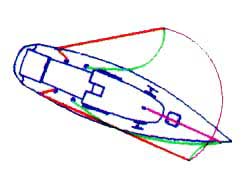 "MADE" This
call comes from the bow person. "MADE" This
call comes from the bow person.
- DRIVER
- Swing the boat onto the new gybe, and hold a steady course. Pay ultimate attention to the apparent
wind angle, and the direction the spinnaker wants to move towards. There are big gainers for not collapsing
the sail! At
this stage it is mostly up to you.
- BOW PERSON
- When the new afterguy is in the pole jaws, and the jaws have closed, call "MADE!" loud enough for
everyone on the boat to hear. The entire crew's
actions are at a standstill until the "made" call is announced. It comes from YOU. Hold the pole until the afterguy pulls
the pole away. This will
prevent a slack afterguy from looping over the end of the pole.
- MAST
- After the "made!" call, repeat the call while looking aft. Wait for tension in the afterguy, then
help pull up the topping lift by bouncing it at the mast. Watch the outboard end of the pole...do not
let it poke straight at the sail, which will be a problem if the topping lift is pulled up too fast,
before the new afterguy is trimmed in.
- TOPPING LIFT
- After the "made!" call, pull up the topping lift. Watch the outboard end of the pole...do not let
it poke straight into the sail. Tearing the foot out of the spinnaker is not a successful conclusion
to a gybe.
- OLD AFTERGUY
- This line has no function and needs no attention.
- NEW SHEET
- Keep the spinnaker full. If the square back went well this should be a one person job for a while.
If you need help call for a grinder.
- FOREGUY
- Watch the pole and prevent the tip from "skying"...going too high.
- NEW AFTERGUY
- No more waiting now!. As soon as the "made" call comes through, grind the pole aft FAST!. This is
typically a two person job.
- OLD SHEET
- Hold on to the old sheet while the afterguy is trimmed aft. Sometimes the old sheet needs to be
eased in order to square the pole to the proper position. Do not let the clew of the sail get past
the headstay.
- MAINSAIL
- As long as the mainsail has gone across, look around for someone who needs help...most likely the
new spinnaker sheet trimmer, who may need a grinder.
-
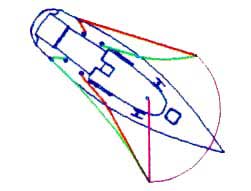 DONE It
is not clear when the gybe is all done! DONE It
is not clear when the gybe is all done!
- DRIVER
- Line the boat up on the new course. Watch the sail and the apparent wind angle...don't gybe back!
Nobody is ready! If the air is light, push the boat up onto a reach right away to build up the boat
speed again. Keep talking to the spinnaker trimmers so they know what you are going to do
next.
- BOW PERSON
- As soon as the pole is made and you know the new afterguy is cleanly in the jaw you are all done
in the bow. Move your weight aft and look for people who need assistance. First choice: help get the
topping lift up, and the spinnaker pole car back down to its normal position. If the lazy spinnaker
sheet is on top the pole (it typically is at the end of a gybe), pull out the slack and wrap the sheet
around the afterguy to prevent the
sheet from falling off the top of the pole.
- MAST
- Move the inboard end of the spinnaker pole car back to its normal sailing
position.
- TOPPING LIFT
- Trim the topping lift to the proper height for the current conditions.
- NEW SHEET
- Back in the saddle again...if the sheet doesn't need to be trimmed in, try easing it until the spinnaker
luffs. Be sure you have a grinder.
- NEW AFTERGUY
- Trim the afterguy to the current apparent wind angle. Help get the spinnaker pole set to the right
height.
- FOREGUY
- Firm up the foreguy when the pole is in it's proper position.
- OLD SHEET
- This is the perfect time to be sure the lazy sheet is over the top of the spinnaker pole. It usually
ends up on top at the end of a gybe. Wind the lazy sheet around the guy to prevent the sheet from falling
off the top
of the pole.
- MAINSAIL
- Trim for the new apparent wind angle.
|

 Kame Richards / Pineapple Sails
Kame Richards / Pineapple Sails



